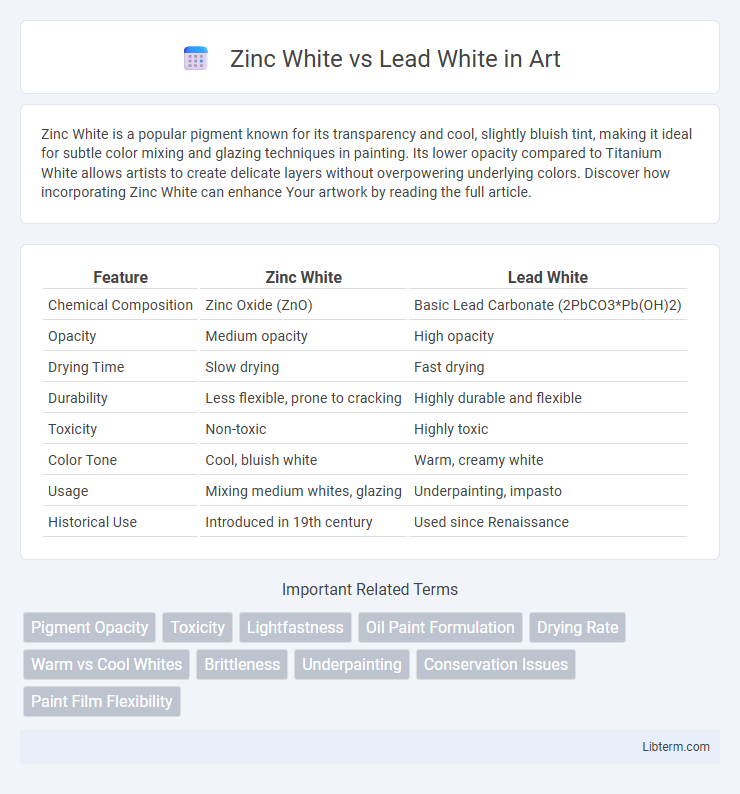Zinc White is a popular pigment known for its transparency and cool, slightly bluish tint, making it ideal for subtle color mixing and glazing techniques in painting. Its lower opacity compared to Titanium White allows artists to create delicate layers without overpowering underlying colors. Discover how incorporating Zinc White can enhance Your artwork by reading the full article.
Table of Comparison
| Feature | Zinc White | Lead White |
|---|---|---|
| Chemical Composition | Zinc Oxide (ZnO) | Basic Lead Carbonate (2PbCO3*Pb(OH)2) |
| Opacity | Medium opacity | High opacity |
| Drying Time | Slow drying | Fast drying |
| Durability | Less flexible, prone to cracking | Highly durable and flexible |
| Toxicity | Non-toxic | Highly toxic |
| Color Tone | Cool, bluish white | Warm, creamy white |
| Usage | Mixing medium whites, glazing | Underpainting, impasto |
| Historical Use | Introduced in 19th century | Used since Renaissance |
Introduction to Zinc White and Lead White
Zinc White, chemically known as zinc oxide, offers a cooler, less opaque alternative to Lead White, which is primarily basic lead carbonate. Lead White has been valued for its durability, high opacity, and smooth blending properties in classical oil painting, while Zinc White is praised for its brightness and lower toxicity. Artists often choose Zinc White to avoid the heavy metal hazards associated with Lead White, seeking a cleaner, more modern pigment option.
Historical Use in Art and Painting
Zinc white gained prominence in the 19th century as a safer alternative to the toxic lead white, which had been the preferred pigment since the Renaissance. Lead white, prized for its opacity and warm hue, was extensively used by masters like Rembrandt and Vermeer for its fast-drying and durable qualities in oil paintings. The transition to zinc white provided artists with a cooler, less toxic pigment, although it dried more slowly and was more brittle, affecting its long-term durability in artworks.
Chemical Composition and Properties
Zinc White, composed primarily of zinc oxide (ZnO), offers a cooler, less opaque finish with slower drying times compared to Lead White, which consists mainly of basic lead carbonate (2PbCO3*Pb(OH)2) and provides superior opacity and faster drying. Zinc White exhibits greater resistance to yellowing and cracking over time, while Lead White is favored for its strong covering power and warm tonal qualities but poses significant toxicity risks. Both whites differ significantly in chemical composition, affecting their handling, durability, and color mixing properties in oil painting applications.
Color and Opacity Comparison
Zinc White offers a cooler, slightly bluish tint compared to the warm, creamy tone of Lead White, affecting color blending and final hues in painting. Zinc White exhibits higher opacity and a more subtle matte finish, whereas Lead White is renowned for its outstanding opacity and smooth, buttery texture that enhances detail and coverage. Artists often choose Zinc White for glazing and delicate color mixing due to its transparency, while Lead White remains favored for bold, opaque applications and durability.
Drying Time and Handling Differences
Zinc White oil paint features a slower drying time compared to Lead White, making it less suitable for artists requiring quick layering and faster paint curing. Lead White dries more rapidly and offers a buttery consistency that facilitates smoother blending and easier handling during application. However, Zinc White is favored for its increased transparency and reduced toxicity, despite its longer drying phase and tendency to produce more brittle films over time.
Longevity and Durability in Paintings
Zinc White offers superior longevity in paintings due to its resistance to yellowing and cracking compared to Lead White, which can darken and become brittle over time. Lead White, while providing excellent opacity and fast drying, often suffers from chemical degradation leading to flaking and reduced durability. Artists seeking archival quality benefit from Zinc White's stability, ensuring artwork maintains vibrancy and structural integrity for centuries.
Health and Safety Considerations
Zinc White, composed primarily of zinc oxide, offers a safer alternative to Lead White, which contains toxic lead carbonate that poses significant health risks such as lead poisoning and neurological damage. Zinc White's lower toxicity makes it preferable for artists concerned with long-term exposure and indoor air quality. Proper ventilation and protective equipment remain essential when handling any white pigments to minimize inhalation of fine pigment particles.
Compatibility with Other Pigments and Mediums
Zinc White exhibits excellent compatibility with a wide range of pigments and mediums, reducing the risk of cracking due to its flexible, less brittle nature compared to Lead White. Lead White, while offering superior opacity and faster drying times, can cause issues when mixed with certain pigments like cadmium reds and yellows, leading to discoloration or instability over time. Artists often prefer Zinc White in oil and acrylic mediums for layering and glazing techniques that require longevity and chemical stability.
Pricing and Availability
Zinc White is generally more affordable and widely available compared to Lead White, which is often priced higher due to its historical significance and toxic nature. Lead White's limited production and strict regulations reduce its accessibility in many markets, making Zinc White the preferred choice for artists seeking both cost-effectiveness and ease of purchase. The non-toxic properties of Zinc White also contribute to its increased availability in art supply stores globally.
Choosing the Right White for Your Artwork
Zinc White offers a cooler, less opaque finish ideal for glazing and subtle mixing, while Lead White provides a warm tone with exceptional opacity and faster drying times favored in classical oil painting. Artists should select Zinc White for delicate layering and longevity, especially in fine detail work, whereas Lead White suits bold, impasto techniques requiring strong coverage and durability. Considering toxicity, Zinc White is safer but less vibrant, making choice dependent on desired visual effects and safety preferences in studio practice.
Zinc White Infographic

 libterm.com
libterm.com